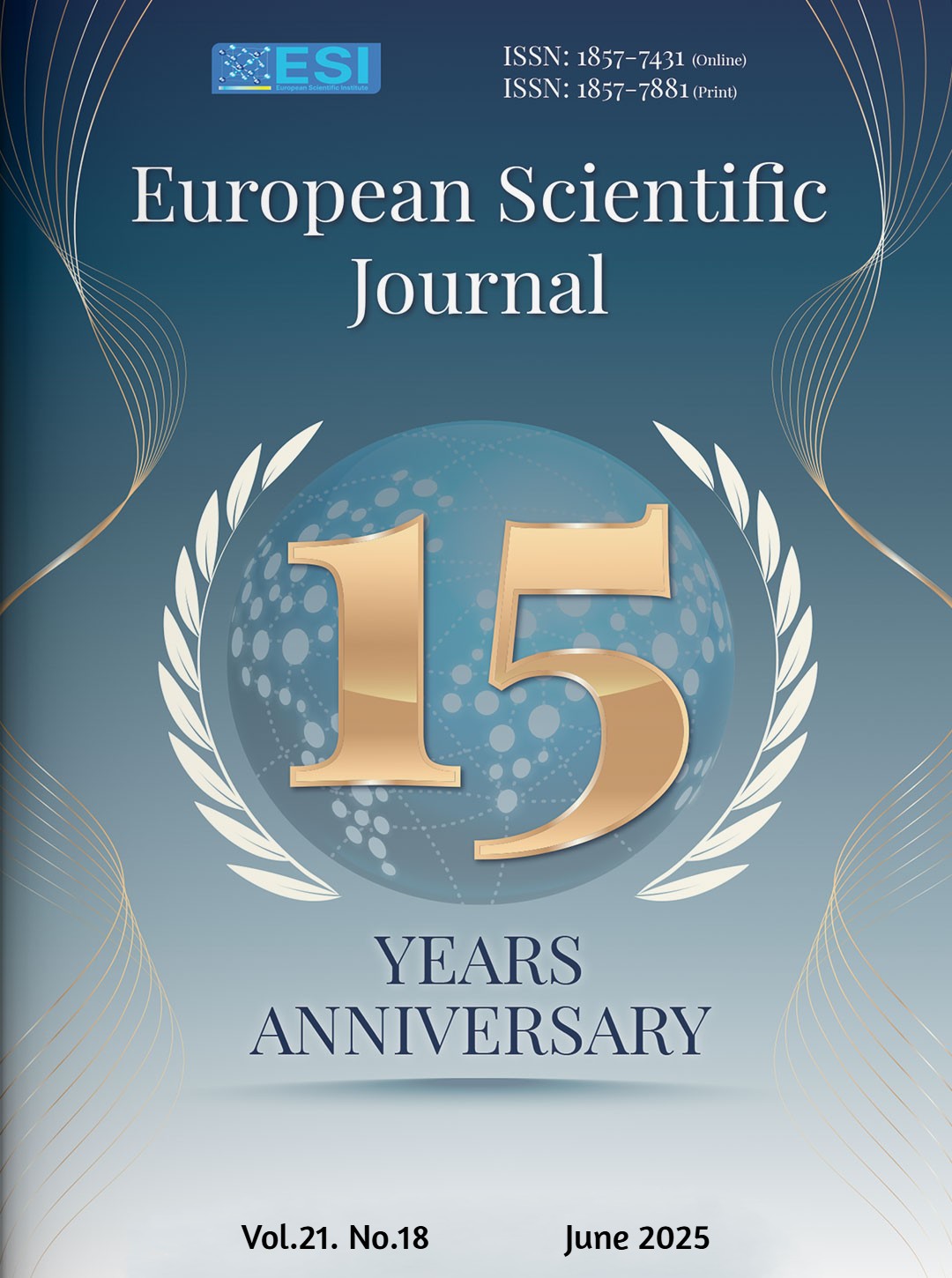Modelling Growth and Yield Components of Okra (Abelmoschus esculentus (L.) Moench) and Ayoyo (Corchorus olitorius (L.)) Using Multiple Regression
Abstract
Multiple regression was employed to model the relationship between growth and yield components of okra (Abelmoschus esculentus (L) Moench) and ayoyo (Corchorus olitorius (L)), with the aim of generating a predictive model. Data on growth parameters and yields of okra and ayoyo crops were collected and analysed using IBM SPSS Statistics 21. Ten (10) plants were tagged in each stream, and a metre rule was used to measure their heights at two-week intervals (2, 4, 6, 8, and 10 weeks). The mean was calculated to obtain the average height per plot/experiment/stream. Data were also collected on the number of leaves per plot, leaf area index per experiment, leaf spread per experiment, and fresh and dry weight per plot. Total nitrogen content was determined using the Kjeldahl method, while phosphorus (P) levels were analyzed using the Bray-P solution method. Additionally, potassium (K) concentrations were measured using the flame photometer method. Results showed an average infiltration rate of 160.25 mm/h, suggesting that the site’s soils belong to hydrologic soil group A/B. Group A consists of sand, loamy sand, or sandy loam soil types. Group B comprises silt loam or loam with moderate infiltration rates, low runoff potential, and high infiltration rates when thoroughly wetted. Due to their moderate to high water transmission rates, these soils are suitable for drip and sprinkler irrigation systems. Notably, there is a strong positive correlation between plant height and leaf area (0.889), and between leaf area and leaf area index (0.981). This suggests that as plant height increases, so does the leaf area, and a similar positive relationship exists between leaf area and the leaf area index. Furthermore, the correlation between the number of leaves and other growth parameters such as leaf area (0.966) and leaf area index (0.988) is also strongly positive. This indicates that an increase in the number of leaves is associated with increases in both leaf area and leaf area index. These correlations, ranging from 0.582 to 0.807, indicate a high degree of association. The high R2 value suggests a strong correlation between predicted and observed yields of okra, indicating reliable predictive capability when the growth parameters of okra are provided. Similarly, for ayoyo, a model equation was developed through regression analysis, yielding an R2 value of 0.941. The yield of ayoyo can thus be predicted during cultivation, provided its growth parameters are known. Hence, this study is focused on establishing a multiple regression model for the growth and yield of okra and ayoyo under different irrigation stream systems.
Downloads
Metrics
PlumX Statistics
References
2. Badr, M.A., El-Tohamy, W.A., Salman, S.R., & Gruda, N., (2022). Yield and water use relationships of potato under different timing and severity of water stress. Agricultural Water Management, 271, p.107793.
3. Bremner, J. M. & Mulvaney, C. S. (1982). Nitrogen - total. Methods of soil analysis: part 2 chemical and microbiological properties, 9, 595-624.
4. Buri, M. M., Issaka, R. N., Senayah, J. K., Fujii, H., & Wakatsuki, T., (2012). Lowland Soils for Rice Cultivation in Ghana. Crop Production in Ghana, 341,p.216671.
5. Canisius, F., Shang, J., Liu, J., Huang, X., Ma, B., Jiao, X., Geng, X., Kovacs, J.M., & Walters, D., (2018). Tracking crop phenological development using multi-temporal polarimetric Radarsat-2 data. Remote Sensing of Environment, 210, pp.508-518.
6. Cristina, N. M. & Lucia, D. A. (2021). Nutrition and healthy aging: Prevention and treatment of gastrointestinal diseases. Nutrients, 13(12), 4337.
7. Chavan, P., Kamble, D., Pansare, D., Shelke, R., & Rai, M. (2024). Analysis of K and Na content of Soil samples by Flame Emission Photometry with other parameters. Asian Journal of Research in Chemistry, 17(6), 337-343.
8. Elkhalifa, A. E. O., Alshammari, E., Adnan, M., Alcantara, J. C., Awadelkareem, A. M., Eltoum, N. E., ... & Ashraf, S. A. (2021). Okra (Abelmoschus esculentus) as a potential dietary medicine with nutraceutical importance for sustainable health applications. Molecules, 26(3), 696.
9. Hossain, A. S. (2023). Healthy okra Growth, Pigments, Vitamin C and mineral Content as Affected by Plant growth Regulators: A Diabetic Food.445, p23567.
10. Johnson, Peter and Sam (2020). "Effect of pH on Calcium Precipitation during Filtration of Industrial Wastewater." Journal of Environmental Chemistry, 48(4), 412-425.
11. Kebede, N. (2019). Effects of Deficit Irrigation and Mulch Levels on Growth, Yield and Water Productivity of Onion (Allium cepa L.) at Werer, Middle Awash Valley, Ethiopia. Haramaya University.
12. Korkmaz, M. (2019). A study over the formulation of the parameters 5 or less independent variables of multiple linear regression. Journal of function spaces, 2019(1), 1526920.
13. Kumar, A. & Jnanesha, A. C. (2022). Tribal Medicine of India: Natural Remedies for Good Health. Indigenus Traditional Knowledge, 47-74.
14. Manjula, E. & S. Djodiltachoumy. (2017). A model for prediction of crop yield. International Journal of Computational Intelligence and Informatics, 6(4): 298-305.
15. Nielsen, D., Johnson, R., & Smith, L. (2017). Soil Infiltration Characteristics in Hydrologic Soil Groups A/B. Journal of Hydrology, 39(4), 315-330.
16. Nkakini, S. O. & R. M. Davies. (2020). Mathematical model equation for tolerance of okra plant yield to soil densification. International Journal of Research and Innovation in Applied Science, V(I), 80-92.
17. Obuobie, E., Keraita, B., Danso, G., Amoah, P., Cofie, O. O., Raschid-Sally, L., & Drechsel, P. (2006). Irrigated urban vegetable production in Ghana: characteristics, benefits and risks.444,p5567.
18. Odey, S. O. (2018). Tractor traffic influence on soil properties, growth and yield of maize in Obubra, Nigeria. International Journal of Engineering Inventions, 7(1), 01-10.
19. Sangeeta, G. S. (2020). Design and implementation of crop yield prediction model in agriculture. International Journal of Scientific and Technology Research, 8(1): 544-549.
20. Sefah, W., Engmann, F. N., Adi, D. D., & Serwah, A. (2024). Health and snutritional perspectives of traditional and ethnic foods in the northern belt of Ghana. In Nutritional and Health Aspects of Food in Western Africa Academic Press, Accra, pp. 111-132).
21. Shaibu, B., Halliru, M., Isyaku, A. M., Bichi, K. D., & Alabi, A. G. (2023). Designing Sustainable Crop Rotations for Intensively Managed Irrigated Lowlands. Practice.
22. Singh, J.S., Koushal, S., Kumar, A., Vimal, S.R., & Gupta, V.K. (2016). Book review: microbial inoculants in sustainable agricultural productivity-Vol. II: functional application.
23. Smith, J., Johnson, R., & Brown, S., (2020). Irrigation: The Deliberate Application of Water to Soil or Plants in Precise Quantities and at the Appropriate Times. Journal of Agricultural Science, 45(3), 321-335.
24. Tang, X. J., Du, Z. Y., Chuang, H. C., Zhu, Y. M., Ji, Y. Y., Li, X. Y., ... & Kuang, H. B. (2021). Enhanced dissolution rate of magnesium hydroxide via magnesia/ammonium acetate hydration system: statistical optimization and possible mechanism. Journal of Chemical Technology & Biotechnology, 96(4), 980-989.
25. Tequam, W.S.P. (2017). Soil Characteristics, Water Resources Development and Environment (Issue in December, 2017), 43-67.
26. Teressa, D., Kibret, K., Dechasa, N., & Wogi, L. (2024). Soil properties and nutrient uptake of maize (Zea mays) as influenced by mixed manure and blended inorganic fertilizer in Haramaya district, eastern Ethiopia. Heliyon, 10(16), 1-14.
Copyright (c) 2025 Alhassan Abdul Latif Husein, Zakaria Issaka

This work is licensed under a Creative Commons Attribution 4.0 International License.








